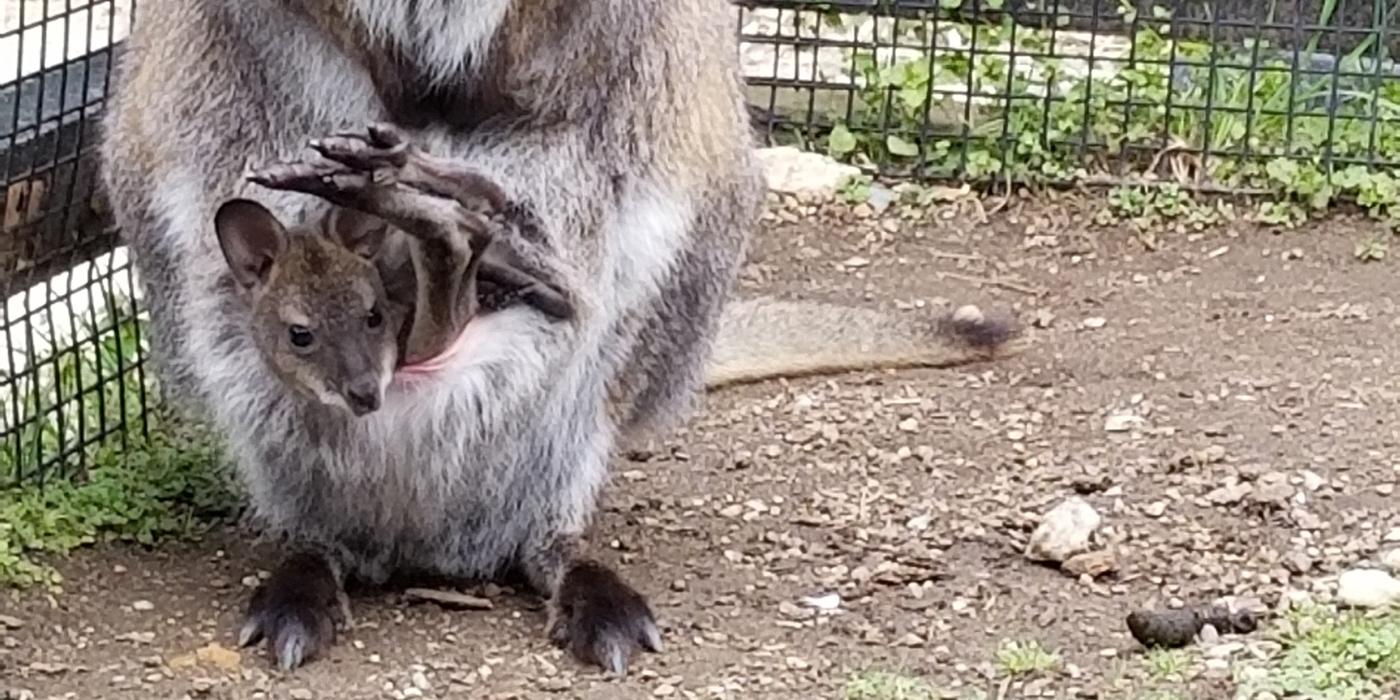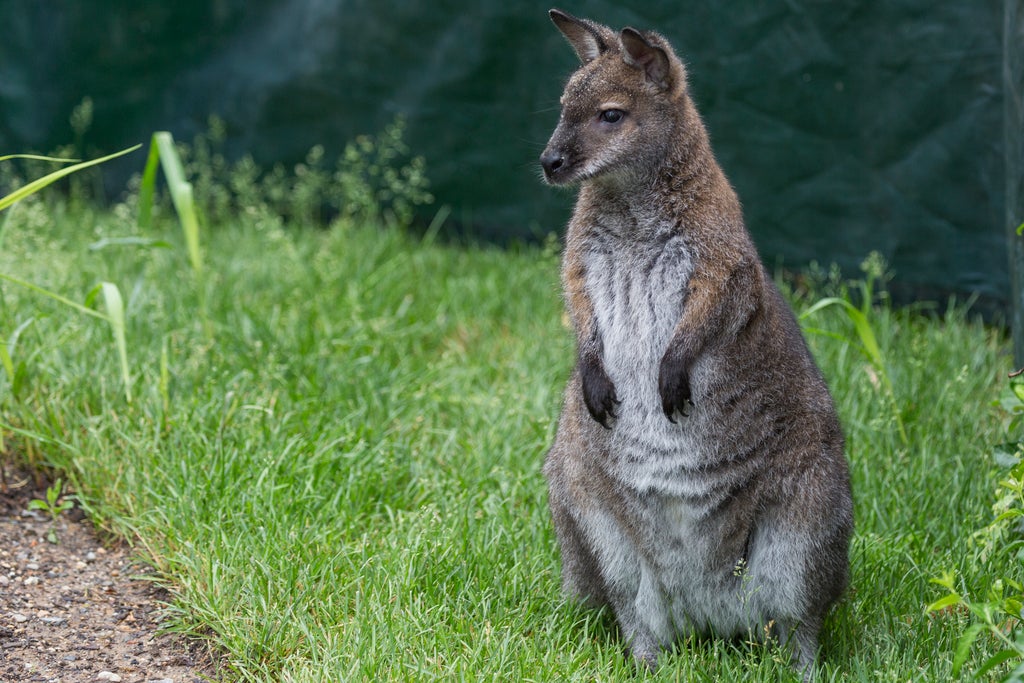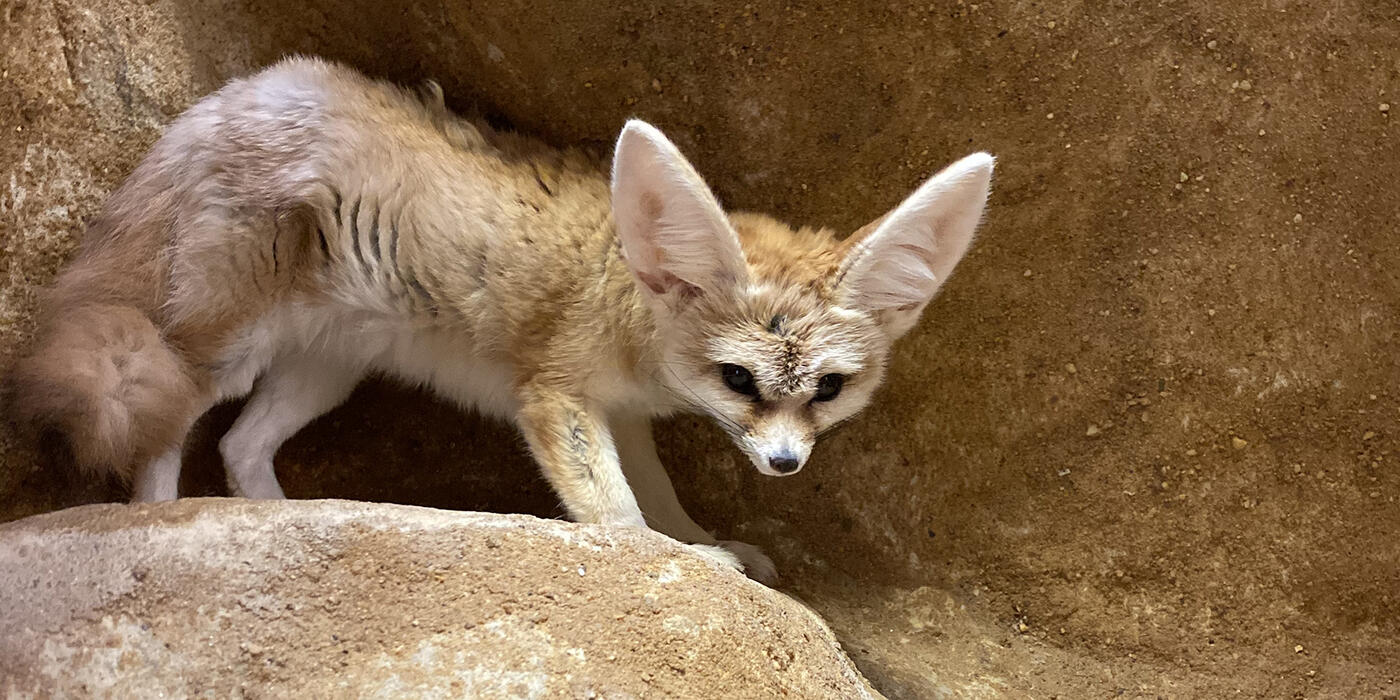New at the Zoo: Wallaby Joey

Things are hop-penning at Small Mammal House! On Jan. 24, a wallaby joey popped its head out of mom Victoria’s pouch. The joey took its first hops outside the pouch on March 18 and has been exploring its yard ever since. Get the scoop on the young joey from animal keeper Esther Wray.
When was the joey born, and is it a boy or girl?
It’s difficult to know for sure when a joey is born, but we believe Victoria gave birth Aug. 10, 2019 (give or take 15 days). This is the second joey for Victoria and dad, Sydney, who unfortunately passed away in September 2019. We don’t know if it’s a male or female yet. When the joey is a little bigger, we will do a quick exam to determine its sex, and then start the naming process!
What is this joey’s personality like? How does it compare to its sister Lenah?
This joey is definitely more of an observer than a doer and not as active as its sister. Even before we saw the joey’s head stick out, it didn’t move around as much as Lenah did in the pouch. Lenah, who was born in fall 2018, was out and exploring just as soon as she could. This guy or gal spends a lot more time in the pouch. During morning cleaning, it is perfectly content to stick its head and feet out and watch us as we work.

The new joey spends its time in the pouch or out playing and exploring — interspersed with lots of naps. Our mob (that’s what we call a group of wallabies) is most active first thing in the morning. As the day gets warmer, they are more inclined to relax in the shade and nap.
Can you tell if a wallaby is pregnant before the joey pops its head out? How long will the joey stay in the pouch?
A joey is blind, hairless and weighs less than a gram (about the size of a kidney bean) when it’s born. The first thing it has to do is crawl up mom’s fur, into the pouch, and attach to a nipple. Mom usually licks a trail for the joey as she's giving birth to help it out. As a baby wallaby gets closer to popping its head out, we can see a little growth begin to form in the area of the mother’s pouch. Then, we’ll start to see movement in the pouch. The joey continues to grow inside the pouch for about 280 days, or until it's around 9 months old.
Can a wallaby have more than one joey at a time?
It is very, very rare for a wallaby to have twins, but it's common for a mom to be caring for multiple joeys at a time. A wallaby mom can nurse two joeys at the same time and produce a different type of milk for each one. Each joey has a specified teat to nurse from, and there could even be a third joey in embryonic diapause – which means that an egg has been fertilized and developed enough to be viable but lays dormant until a teat becomes available.
Will a wallaby joey go back into the pouch after it has left for the first time?
Yes! Our baby wallaby goes in and out of the pouch constantly right now. It returns to mom for warmth and to nurse. Eventually, it will grow too big and Victoria will not let it back in the pouch.
What does the young joey eat?
Both Lenah and the new joey started eating grass as their first solid food. Before they even grew hair, I would see them smell and lick the ground as Victoria leaned over to eat. They eventually worked their way up to chewing. I’ve seen the new joey trying hay a few times, which is also a big hit with Lenah. We also feed the wallabies leafy branches (called browse), sweet potatoes, apples and nutritious biscuits specifically formulated for marsupials.
Do wallabies make noise or have other ways of communicating?
Wallabies can vocalize but rarely do. Usually, they grumble at each other when displeased. Lenah, however, could not find Victoria one day when she was 8 months old and chirped for her.
Where are Bennett’s wallabies from, and what is something people can do to help conserve them?
Bennett’s wallabies are native to Australia’s eastern coast, where they can be found from Queensland to Victoria and in parts of South Australia. They also live in Tasmania. Taking action to protect a species before it becomes threatened is the best way to keep animals from becoming endangered, so supporting regional conservation initiatives and efforts to conserve macropods (marsupials like kangaroos, wallabies and more) in Australia is important. Readers can also share what they love about Bennett’s wallabies with friends and family. Simply raising awareness about this species can contribute to their long-term protection.
What are a few of your favorite wallaby facts?
Female wallabies are referred to as “flyers” or “Jills,” and males are called “boomers” or “Jacks.” Wallabies will sometimes regurgitate, or throw up, their food and then chew it a second time — just like cows. They don’t sweat or pant, so to cool off when it is hot, they lick their forearms and let the moisture evaporate.

When wallabies are not hopping, their method of moving is called “pentapedal locomotion.” They place their forelimbs and tail on the ground, and then use their tail as an anchor and move their hind legs forward. It looks like crawling.
Is there anything else readers should know about the new joey?
Adelaide, our other adult female, and the joey will sniff each other when the joey sticks its head out of the pouch. As the joey has gotten older, Victoria has started to let Lenah investigate it, too. For a while, Victoria would avoid Lenah or fuss at her to back off, but now they are back to grooming and laying near each other. Usually, these interactions happen with all three adults gathered around a food bowl. Meals bring families together!
Though the Zoo is temporarily closed to the public, keepers continue to provide the highest quality of animal care to all its residents. Want to help replenish toys, puzzle feeders and training tools that are a bit run-down yet well loved by the Zoo’s animals? Donate to the Enrichment Trunk. Your support directly benefits the animals at the Smithsonian’s National Zoo and Conservation Biology Institute.
This story appears in the May 2020 issue of National Zoo News.
Related Species:


